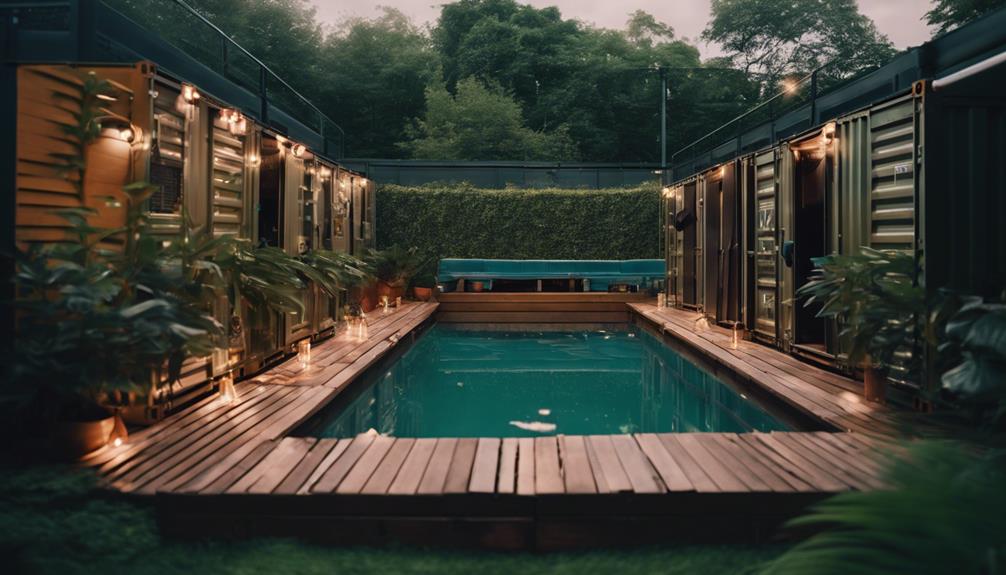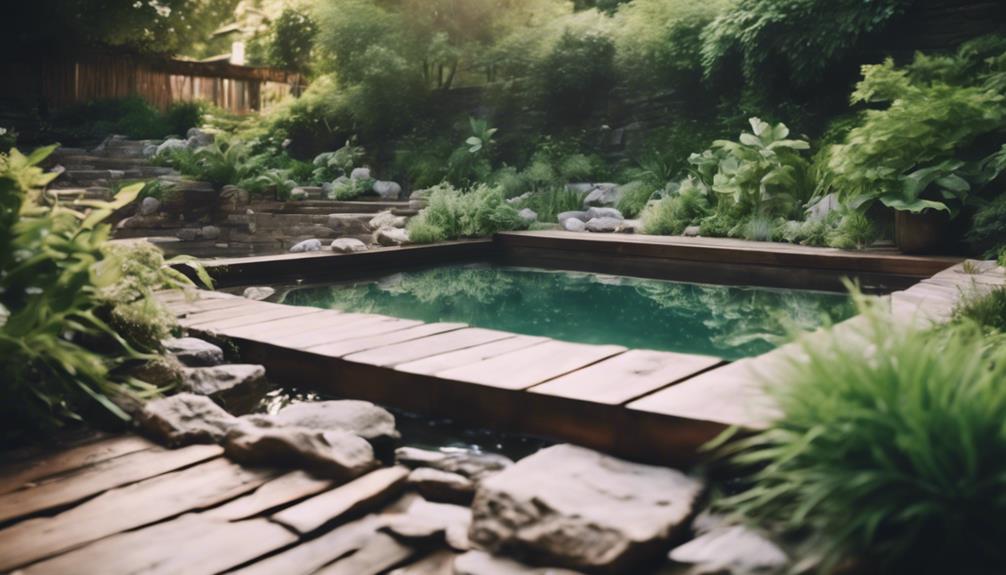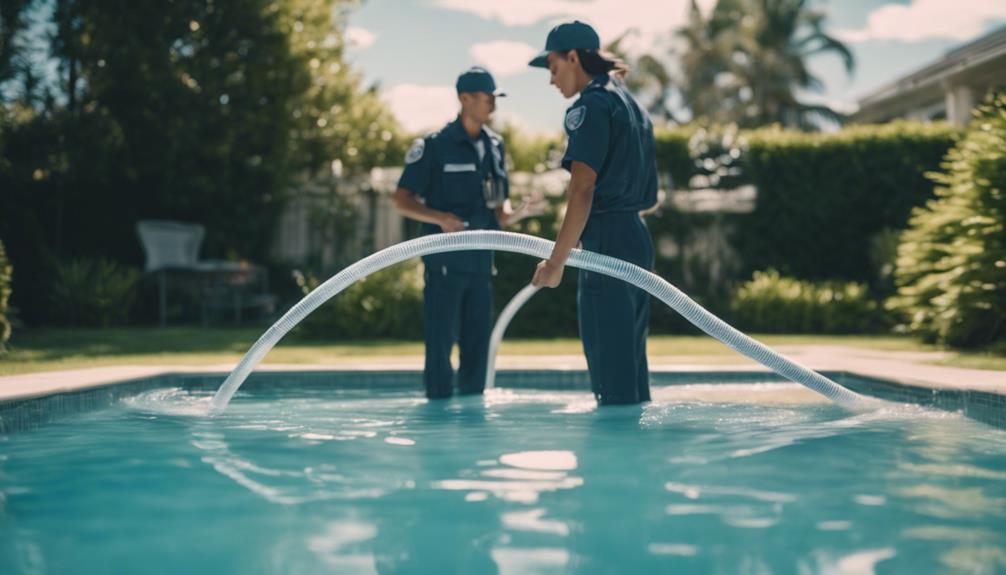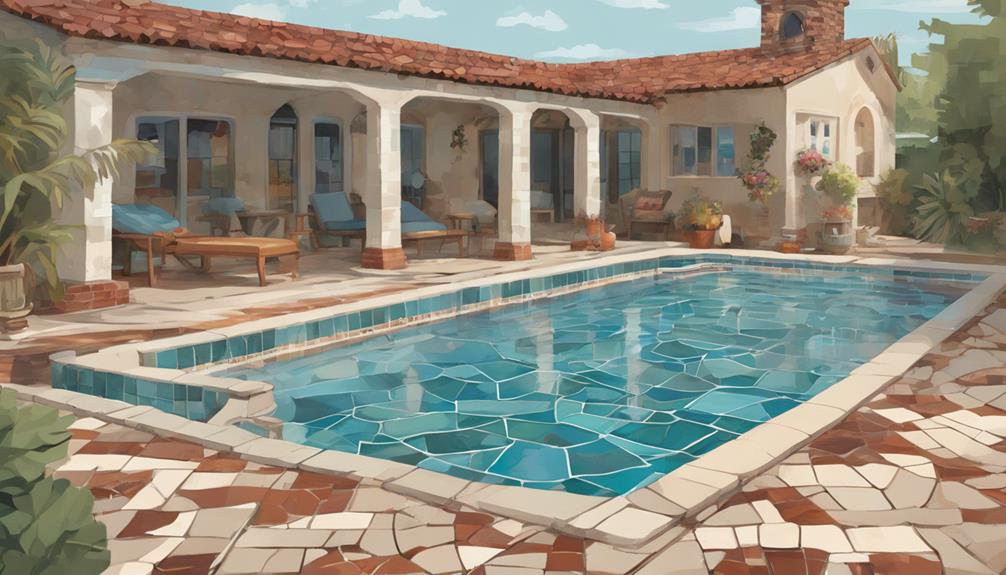Set up your own affordable swimming pool oasis using a large container, pool liner, and pump system. Choose a sunny spot, excavate the shape, and secure the liner. Consider using solar-powered circulation for energy efficiency and add landscaping for added appeal. Keep it well-maintained by regularly cleaning filters, testing the water, and inspecting for wear and tear. For inspiration, look to natural pools, utilize solar energy, and include heat-retention elements. These DIY concepts provide relaxation and environmental benefits. Delve deeper to find a comprehensive guide, necessary materials, creative design concepts, and maintenance advice for a durable homemade swimming pool.
Key Takeaways
- Incorporate natural elements for a cost-effective and eco-friendly pool option.
- Utilize solar-powered circulation systems for energy efficiency.
- Design with heat retention in mind using insulation techniques.
- Create a deep swimming zone for added enjoyment.
- Ensure a smooth liner fit for a professional finish.
Benefits of DIY Natural Pools
Building your own natural pool comes with numerous advantages that make it a popular choice for DIY enthusiasts. When it comes to swimming pools, DIY natural pools offer cost-effectiveness compared to commercial installations. You can save money on both construction and maintenance, making it an attractive option for those looking to enjoy a pool without breaking the bank.
Moreover, DIY natural pools eliminate the need for specialized contractors, allowing you to take on the project yourself. By avoiding chemical pesticides commonly used in traditional pools, these natural pools create a healthier environment for swimmers and wildlife alike.
Additionally, the solar-powered circulation systems found in DIY natural pools operate in an eco-friendly manner, reducing energy consumption and lowering your environmental impact.
The presence of plants and animals within DIY natural pools also plays a significant role in maintaining water quality. These natural elements help filter and oxygenate the water, ensuring an invigorating and clean swimming experience for you and your family.
Materials Needed for Construction

To construct your homemade swimming pool, gather essential materials such as a large container, a pool liner, a pump and filter system, and plumbing fittings. These items form the foundation for your swimming pool project, ensuring proper water circulation and maintenance.
Additionally, consider incorporating insulation to retain heat, sandbags, or oak sleepers for creating smooth walls, and scrap materials for DIY filter construction. For an added touch of aesthetics and camouflage, reed fencing can be easily obtained from stores like Lowes, enhancing the visual appeal of your swimming pool area.
To promote sustainability and reduce environmental impact, you may also opt to utilize solar power for energy-efficient pool circulation. By creating a DIY natural swimming pool, you can establish a chemical-free environment that supports biodiversity and a healthy ecosystem within the pool.
These materials not only facilitate the construction process but also contribute to the overall functionality and eco-friendliness of your homemade swimming pool.
Step-by-Step Installation Guide

Consider selecting a suitable location with proper sunlight exposure and level ground for stability when installing your DIY ground pool.
Begin by digging out the area to match your desired pool size and shape, ensuring a smooth and even base for the pool liner.
Next, install a high-quality pool liner securely to the walls and bottom of the pool area to prevent leaks and ensure durability.
For eco-friendly operation, incorporate a solar-powered circulation system to promote water health and reduce energy costs.
Finally, enhance the overall aesthetic appeal by finishing off your DIY pool with landscaping around the edges, such as rocks, plants, or decking.
Maintenance Tips for Longevity

Regularly cleaning the pool filters and skimmers is essential for ensuring proper water circulation and filtration, preventing debris buildup, and maintaining water clarity in your homemade swimming pool.
Testing the pool water frequently using a test kit is vital to maintain the correct pH levels and chemical balance, promoting swimming sanitation and water clarity.
Keep an eye on the water levels to prevent damage to the pool liner and equipment, ensuring ideal performance and longevity for your swimming oasis.
Inspecting the pool structure for any signs of wear or damage is important; addressing issues promptly can prevent costly repairs and maintain the structural integrity of your swimming pool.
Finally, covering the pool when not in use is a simple yet effective way to protect it from debris, UV rays, and evaporation, ultimately extending its lifespan and reducing overall maintenance requirements.
Creative Design Ideas for Inspiration

For unique and imaginative design inspirations for your homemade swimming pool, explore creative ideas that blend functionality with aesthetic appeal. When designing your pool, consider incorporating elements from natural pools to create a cost-effective and eco-friendly oasis.
Opt for a solar-powered circulation system to reduce energy consumption and eliminate the need for chemical pesticides. Construct your pool with techniques like insulating for heat retention, creating smooth walls without cutting liners, and using domestic plumbing for silent operation.
Design features such as a deep swimming zone, smooth liner fit with sandbag walls, equal areas for plants and animals for water health, and nutrient control to prevent algae growth can enhance the overall look and functionality of your pool. Embrace sustainability by utilizing solar energy, supporting biodiversity, ensuring energy-efficient operation, and promoting a natural ecosystem within your pool.
Frequently Asked Questions
How to Make a Cheap Swimming Pool?
Looking to make a cheap swimming pool? Try using a stock tank for an affordable DIY option. Customize it to fit your needs and space. Don't overlook above ground pool pumps for proper water circulation.
Can You Build Your Own Plunge Pool?
You can definitely build your own plunge pool! It's a fun and manageable DIY project that doesn't require much space. Using stock tanks, containers, or fiberglass shells, you can create a cost-effective oasis for relaxation.
What Can I Use as a Swimming Pool?
You can get creative and transform ordinary items into a swimming pool oasis. Anything from a stock tank to simple DIY projects can turn your backyard into a rejuvenating retreat. The possibilities are virtually endless!
How Do You Build an Eco Friendly Pool?
To build an eco-friendly pool, you can use natural filtration like plants, employ solar-powered circulation systems, and focus on sustainable construction techniques. By incorporating biodiversity and design features, you create a cost-effective, environmentally conscious swimming pool.
What are the Benefits of Building a Homemade Swimming Pool?
Building a homemade swimming pool can offer a range of benefits. You have the freedom to customize the design based on your preferences and available space. With a variety of homemade swimming pool ideas, you can create a unique and personalized oasis right in your own backyard.
What are the Benefits of Using Stock Tank Swimming Pools for DIY Homemade Swimming Pool Ideas?
Looking for rustic stock tank pool ideas? Using stock tank swimming pools for DIY homemade swimming pool ideas has many benefits. They are cost-effective, easy to install, and can be customized to fit any space. Additionally, they provide a unique and charming aesthetic to your backyard oasis.
What are the Benefits of Homemade Swimming Pools compared to professionally built ones?
When it comes to diy swimming pool ideas, homemade swimming pools offer several benefits compared to professionally built ones. They are often more affordable, allow for greater customization, and can be a fun and rewarding DIY project. Additionally, homemade pools can be designed to fit smaller or uniquely shaped spaces.
Are Stock Tank Swimming Pools Safe to DIY at Home?
Looking for rustic stock tank swimming pool ideas for your DIY project at home? Safety measures should be your top priority. Make sure to properly seal any seams or openings to prevent leaks. Additionally, consider adding a non-slip surface to the bottom to prevent accidents. Enjoy your new pool responsibly!
Conclusion
To sum up, DIY natural pools offer a cost-effective and environmentally friendly way to enjoy a revitalizing swim right in your own backyard. By following the step-by-step installation guide and implementing proper maintenance tips, you can create a beautiful oasis that will provide endless hours of relaxation and enjoyment.
Get creative with your design ideas and let your imagination run wild as you transform your outdoor space into a homemade swimming pool paradise.










